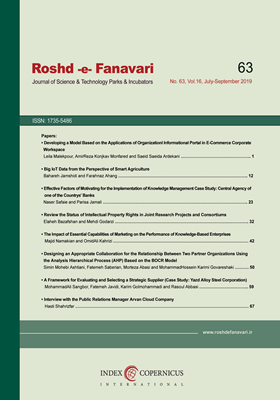Review the Status of Intellectual Property Rights in Joint Research Projects and Consortiums
Subject Areas : مالکیت فکری و مدیریت سرمایههای نامشهودelahe bazrafshan 1 , mehdi goodarzi 2 *
1 -
2 - Allameh Tabataba’I University
Abstract :
Today, the use of joint research and development has facilitated technological progress, which has led to the production of new products, processes and services for the market. In order to protect these achievements, intellectual property rights in international technological cooperation as well as collaborative research projects between the private and public sectors, especially in the field of patents, have become twofold important. Intellectual property plays an essential role in promoting this type of collaboration between the university, industry and government and plays a complementary role in technology development. But a look at Iran's intellectual property policies in joint research projects and consortiums in the past shows that there is no coherent and complete framework for intellectual property arising from these collaborations, so the main purpose of this study is to examine the role of intellectual property rights in joint research projects and consortiums and political advice to those involved. This research is a review of the literature and uses a library methodology and in-depth study of available literature and articles and internal and external books on intellectual property and joint research projects, and specifically on model agreements in the Consortium of Europe and the United Kingdom, and finally a model agreement has been proposed to managers and policy makers active in the field of science and technology development in Iran, given that such agreements are less visible.
1- گودرزی، مهدی، اسماعیلی، الههالسادات، مدیریت داراییهای فکری در پژوهشگاههای دولتی ایران: یک مطالعه چند موردی، رهیافت، 55، پاییز و زمستان 1392، 52-33.
2- ذاکر صالحی، غلامرضا، نقش دانشگاهها در توسعه و نهادینهشدن نظام حقوق مالکیت فکری، پژوهشهای حقوق تطبیقی، 18، 1393، 102-71.
3- خانی، ریحانه، نصراللهی، زهرا، بررسی رابطه بین حقوق مالکیت فکری و توسعه (کشورهای منتخب در حال توسعه و توسعهیافته)، فصلنامه سیاستگذاری پیشرفت اقتصادی دانشگاه الزهرا (س)، 3(6)، 1394، 93-67.
4- Belderbos, Rene, et al. "Co-ownership of intellectual property: Exploring the value- appropriation and value- creation implications of co-patenting with different partners." Research policy 43.5 (2014).
5- Arthur, J. F.; Hodge, R. M.; 2013; “A Model for Managing Intellectual Property, Commercialisation and Technology Transfer within a Collaborative Research Environment”; International Journal of Economics and Management Engineering, Vol: 7, No: 12.
6- Hanebuth, A., & Klossek, A. (2011). IP management in the Triple Helix context: evidence from a German research project. In Triple Helix IX International Conference- Silicon Valley: Global Model or Unique Anomaly.
7- Hagedoorn, John. "Sharing intellectual property rights—an exploratory study of joint patenting amongst companies." Industrial and Corporate Change 12.5 (2003): 1035-1050.
8- Schacht, Wendy H. "The Bayh- Dole act: selected issues in patent policy and the commercialization of technology." Library of Congress Washington DC Congressional Research Service, 2009.
9- Ewing, Thomas, A Practical guide for Valuing Intantgible Asseets in research and Development Institutions ,Committee on Development and Intellectual Property (CDIP), Seventeenth Session, 2016.
10- Mbonteh, Faithfull Munka. Open innovation and intellectual property management. MS thesis. UHasselt, 2017.
11- Gargate, G., & Momaya, K. (2018). Intellectual property management system: Develop and self-assess. World Patent Information, vol 52 (2018) 29e41.
12- Fact sheet on "How to deal with IP related clauses within Consortium Agreements", 2015, retrieved from: http://www. iprhelpdesk.eu/Fact- Sheet- How- to- Deal- with- IP- Related- Clauses- within- FP7- CA.
13- Manzini, Raffaella, and Valentina Lazzarotti. "Intellectual property protection mechanisms in collaborative new product development." R&D Management 46. S2 (2016): 579-595.
14- Camarinha- Matos L. M., Afsarmanesh H. (2001), A Systematic Approach to IPR Definition in Cooperative Projects. In: Camarinha- Matos L.M., Afsarmanesh H., Rabelo R.J. (eds) E-Business and Virtual Enterprises. PRO- VE 2000. IFIP — The International Federation for Information Processing, vol 56. Springer, Boston, MA.
15- Omidvar, Omid; 2013; “Collaboration for reseach and development: understanding absorbtive capacity and learning in R&D consortia across phases, levels, and boundaries”, Ph.D. thesis.
16- INPI, 2013, “Collaborative innovation and intellectual property”, paris.
17- European Commission, (2002), “Expert Group Report on Role and Strategic Use of IPR (Intellectual Property Rights) in International Research Collaborations”.
18- Nugent, Neill, and Mark Rhinard. The european commission. Macmillan International Higher Education, 2015.
19- "University and business collaboration agreements: Lambert Toolkit", 2016, retrieved from: https://www.gov.uk/guidance/university-and-business-collaboration-agreements-lambert-toolkit.

